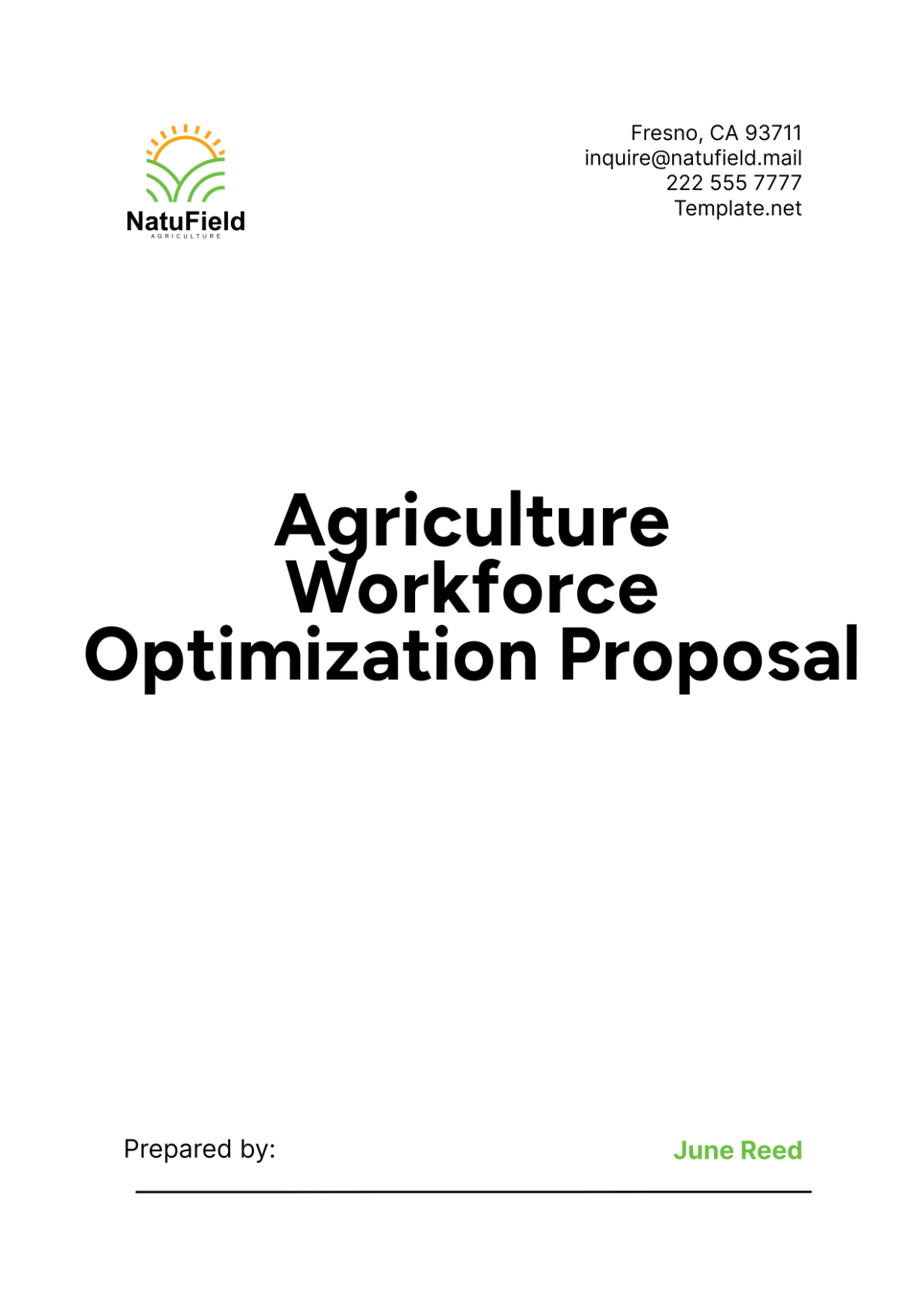Agriculture Workforce Optimization Proposal
I. Executive Summary
A. Overview
The Agriculture Workforce Optimization Proposal aims to revolutionize [Your Company Name]'s agricultural operations by integrating advanced technologies and optimizing workforce management strategies. In today's dynamic agricultural landscape, where challenges such as labor shortages and fluctuating market demands persist, this proposal offers a comprehensive solution to enhance productivity, reduce operational costs, and improve overall workforce satisfaction. By leveraging cutting-edge technologies like automation, drones, and data analytics, combined with targeted training programs and optimized resource allocation, [Your Company Name] seeks to establish itself as a leader in sustainable and efficient agricultural practices.
B. Objectives
Increase Productivity: By implementing state-of-the-art technologies and streamlined processes, [Your Company Name] aims to achieve a 20% increase in productivity within the first year.
Reduce Labor Costs: Optimizing resource allocation and reducing dependency on manual labor is projected to result in a 15% reduction in labor costs.
Enhance Worker Skills: Through comprehensive training programs and certifications, [Your Company Name] plans to elevate worker skills, aiming for a 25% improvement in skill levels across the workforce.
Implement Advanced Technologies: The adoption of automation, drones, and data analytics will not only streamline operations but also pave the way for sustainable agricultural practices.
Improve Worker Satisfaction: By focusing on better working conditions, career development opportunities, and engagement initiatives, [Your Company Name] targets a 25% improvement in worker satisfaction and a reduction in turnover rates.
II. Current Workforce Analysis
A. Workforce Demographics
The current workforce at [Your Company Name] comprises approximately 1,000 employees, including full-time, part-time, and seasonal workers. The demographic profile primarily consists of individuals aged between 25-45 years, with a diverse range of skills and experiences within the agricultural sector. Full-time employees constitute 50% of the workforce, followed by 30% part-time and 20% seasonal workers, reflecting the seasonal nature of agricultural activities.
B. Skill Levels
A comprehensive skills assessment reveals varying levels of proficiency among [Your Company Name]'s workforce:
Highly Skilled: Approximately 10% of the workforce demonstrates advanced skills in specialized areas such as precision farming and organic agriculture.
Moderately Skilled: 40% of employees possess intermediate skills necessary for routine agricultural tasks, machinery operation, and basic crop management.
Unskilled: The remaining 50% of workers lack formal training or proficiency in advanced agricultural practices, presenting opportunities for skill development and enhancement.
C. Current Challenges
Labor Shortages: Like many agricultural enterprises, [Your Company Name] faces recurrent challenges related to labor shortages, particularly during peak seasons such as planting and harvesting. The seasonal nature of agricultural work exacerbates these shortages, impacting operational continuity and efficiency.
Skill Gaps: A significant portion of [Your Company Name]'s workforce lacks specialized skills required for modern agricultural practices, including the use of advanced machinery, data analytics, and sustainable farming techniques. Addressing these skill gaps is crucial for improving productivity and operational efficiency.
High Turnover Rates: Seasonal workers contribute to high turnover rates, resulting in increased recruitment and training costs. Retaining skilled workers and enhancing job satisfaction are essential for maintaining consistency and productivity throughout the year.
Inconsistent Productivity: Variations in productivity levels across different seasons and operational phases indicate a need for more efficient resource allocation, better training, and enhanced technological integration to optimize workflow and output.
III. Proposed Optimization Strategies
A. Advanced Technology Implementation
Automation and Robotics:
Automation plays a pivotal role in transforming agricultural operations at [Your Company Name]. By deploying automated machinery for planting, harvesting, and packaging, [Your Company Name] aims to reduce reliance on manual labor and increase operational efficiency. Automated harvesters, for instance, can significantly enhance harvesting speed and accuracy, thereby reducing labor costs and improving yield consistency.
Automated systems not only streamline repetitive tasks but also minimize human error, ensuring higher product quality and operational reliability. Integrating robotics into daily operations will require substantial initial investment in state-of-the-art equipment and ongoing maintenance to maximize efficiency and longevity.
Drones and Sensors:
Drones and sensor technologies offer valuable insights into crop health, soil conditions, and irrigation requirements at [Your Company Name]. Equipped with high-resolution cameras and multispectral imaging capabilities, drones enable real-time monitoring of crop growth, pest infestations, and nutrient deficiencies across vast agricultural landscapes.
By capturing and analyzing data from drones and ground sensors, [Your Company Name] can make informed decisions regarding crop management practices and resource allocation. Soil sensors, for instance, provide critical information on soil moisture levels, temperature variations, and nutrient concentrations, enabling precise irrigation and fertilization strategies tailored to specific crop needs.
Data Analytics:
Data analytics forms the backbone of [Your Company Name]'s decision-making processes, facilitating predictive modeling, yield forecasting, and supply chain optimization. By harnessing big data analytics tools, [Your Company Name] can identify trends, anticipate market demand fluctuations, and optimize production schedules accordingly.
Advanced analytics platforms analyze historical and real-time data to detect patterns, anomalies, and opportunities for operational improvement. By integrating data-driven insights into daily operations, [Your Company Name] can enhance operational efficiency, reduce waste, and optimize resource utilization across its agricultural enterprises.
B. Enhanced Training Programs
Skill Development Workshops:
[Your Company Name] recognizes the importance of continuous learning and skills development in fostering a skilled and adaptable workforce. Regular skill development workshops and training sessions are designed to equip employees with the latest agricultural techniques, machinery operation skills, and safety protocols.
These workshops, conducted by industry experts and internal trainers, cover topics ranging from precision agriculture and integrated pest management to sustainable farming practices. By investing in employee training and upskilling initiatives, [Your Company Name] aims to empower its workforce, enhance job satisfaction, and improve overall productivity.
Online Training Modules:
In response to the evolving needs of a geographically dispersed workforce, [Your Company Name] offers online training modules accessible via mobile devices and desktop computers. These self-paced modules provide flexible learning opportunities for employees to acquire knowledge and skills at their convenience, regardless of location or time constraints.
Online training modules cover a wide range of topics, including crop rotation techniques, irrigation management, and environmental sustainability practices. Interactive quizzes, video tutorials, and virtual simulations enhance engagement and retention, ensuring that employees gain practical insights and actionable skills applicable to their roles.
Certification Programs:
[Your Company Name] collaborates with accredited institutions and industry partners to offer certification programs in specialized agricultural disciplines. These certification programs validate employees' competencies in areas such as organic farming, greenhouse management, and food safety standards, aligning with industry best practices and regulatory requirements.
Certification courses combine theoretical knowledge with hands-on practical training, enabling participants to apply learned concepts in real-world agricultural settings. By obtaining recognized certifications, employees enhance their professional credentials, career advancement prospects, and contributions to [Your Company Name]'s operational excellence.
C. Optimized Resource Allocation
Workforce Management Software:
[Your Company Name] deploys advanced workforce management software to optimize scheduling, task allocation, and performance tracking across its agricultural operations. This integrated software solution provides real-time visibility into labor requirements, skills availability, and operational demands, enabling proactive decision-making and resource allocation.
Automated scheduling algorithms consider factors such as employee preferences, seasonal workload fluctuations, and production deadlines to optimize workforce utilization. Real-time performance dashboards and analytics empower supervisors to monitor productivity metrics, identify bottlenecks, and implement corrective actions promptly.
Flexible Work Arrangements:
Recognizing the diverse needs and preferences of its workforce, [Your Company Name] introduces flexible work arrangements to enhance employee satisfaction and retention. Flexible scheduling options, including part-time shifts and remote work opportunities during non-peak seasons, accommodate employees' personal commitments while maintaining operational efficiency.
By promoting work-life balance and offering flexible work arrangements, [Your Company Name] reduces absenteeism, enhances job satisfaction, and fosters a supportive work environment. Employee morale and productivity benefit from increased autonomy and flexibility in managing work schedules and responsibilities.
Incentive Programs:
[Your Company Name] implements performance-based incentive programs to recognize and reward employees for outstanding contributions to operational excellence and productivity goals. These incentive programs motivate employees to achieve individual and team performance targets, driving continuous improvement and organizational success.
Incentives may include monetary bonuses, merit-based promotions, and recognition ceremonies to celebrate employees' achievements. By aligning incentives with key performance indicators (KPIs) and strategic objectives, [Your Company Name] reinforces a culture of accountability, collaboration, and high-performance across its workforce.
D. Worker Satisfaction and Retention
Improved Working Conditions:
[Your Company Name] prioritizes the health, safety, and well-being of its workforce by investing in improved working conditions and facilities. Upgrades to onsite housing, sanitation facilities, and recreational amenities enhance employee comfort and satisfaction, contributing to a positive work environment.
Enhanced working conditions reduce employee turnover rates, minimize absenteeism due to health-related issues, and promote overall job satisfaction. By fostering a supportive workplace culture and prioritizing employee welfare, [Your Company Name] cultivates a motivated and resilient workforce committed to achieving organizational goals.
Employee Engagement Initiatives:
[Your Company Name] fosters a culture of open communication, collaboration, and teamwork through targeted employee engagement initiatives. Regular feedback sessions, team-building activities, and social events create opportunities for employees to connect, share ideas, and contribute to organizational success.
Employee engagement initiatives include town hall meetings, employee recognition programs, and cross-departmental projects that promote camaraderie and unity among team members. By soliciting feedback and valuing employee input, [Your Company Name] strengthens morale, enhances job satisfaction, and fosters a sense of belonging within the organization.
Career Development Opportunities:
[Your Company Name] prioritizes professional growth and career advancement opportunities for its workforce through structured career development programs and leadership training initiatives. These programs equip employees with essential skills, knowledge, and competencies needed to thrive in evolving agricultural landscapes.
Career development opportunities include mentorship programs, skills assessments, and personalized development plans tailored to employees' career aspirations and organizational needs. By investing in employee growth and succession planning, [Your Company Name] cultivates a pipeline of future leaders capable of driving innovation and sustaining long-term business success.
IV. Implementation Plan
A. Phase 1: Planning and Assessment (Months 1-3)
During the initial phase of the implementation plan, [Your Company Name] will focus on conducting a comprehensive assessment of current workforce capabilities, technology infrastructure, and operational workflows. Key activities include:
Workforce Assessment: Conducting skill audits, identifying training needs, and assessing workforce readiness for technological integration.
Project Planning: Developing a detailed project plan encompassing timelines, milestones, resource allocation, and budgetary considerations.
KPI Identification: Defining key performance indicators (KPIs) to measure the success and impact of optimization strategies across different operational units.
B. Phase 2: Technology Integration (Months 4-6)
The second phase of the implementation plan will involve the procurement, installation, and integration of advanced technologies essential to [Your Company Name]'s agricultural operations. Key activities include:
Technology Procurement: Acquiring automated machinery, drones, sensors, and data analytics platforms from reputable suppliers and technology partners.
Training and Capacity Building: Providing hands-on training and technical workshops to familiarize employees with new technologies, safety protocols, and operational best practices.
System Integration: Ensuring seamless integration of new technologies with existing infrastructure and operational workflows to optimize efficiency and performance.
C. Phase 3: Training and Development (Months 7-9)
In the third phase, [Your Company Name] will launch comprehensive training and development programs designed to enhance employee skills, knowledge, and competencies. Key activities include:
Training Program Rollout: Implementing skill development workshops, online training modules, and certification courses tailored to meet specific job roles and operational requirements.
Evaluation and Feedback: Monitoring training effectiveness, gathering employee feedback, and making continuous improvements to training content and delivery methods.
Certification and Accreditation: Collaborating with accredited institutions and industry partners to offer recognized certifications in specialized agricultural disciplines.
D. Phase 4: Resource Optimization (Months 10-12)
During the fourth phase, [Your Company Name] will focus on optimizing resource allocation, workforce management, and operational workflows to maximize productivity and efficiency. Key activities include:
Workforce Management Software Deployment: Implementing advanced workforce management software to streamline scheduling, task allocation, and performance tracking.
Flexible Work Arrangements: Introducing flexible work schedules and remote work options to accommodate seasonal workload fluctuations and employee preferences.
Incentive Program Launch: Establishing performance-based incentive programs to motivate employees, reward excellence, and foster a culture of accountability and continuous improvement.
E. Phase 5: Continuous Improvement (Ongoing)
Continuous improvement is integral to [Your Company Name]'s operational philosophy, emphasizing iterative refinement and adaptation of optimization strategies. Key activities include:
Performance Monitoring: Regularly monitoring and analyzing key performance indicators (KPIs) to assess the impact of optimization strategies on productivity, cost efficiency, and workforce satisfaction.
Feedback Mechanisms: Soliciting feedback from employees, stakeholders, and customers to identify opportunities for improvement and innovation.
Adaptive Strategy: Adapting strategies and operational workflows based on data-driven insights, market trends, and emerging technological advancements to maintain competitiveness and sustainability.
V. Financial Plan
A. Budget Breakdown
The financial plan outlines the budgetary allocation for implementing [Your Company Name]'s Agriculture Workforce Optimization Proposal. Key budget items include:
Item | Cost (USD) | Description |
|---|---|---|
Advanced Machinery | $500,000 | Automated harvesters, planters, and packaging equipment |
Drones and Sensors | $200,000 | Crop monitoring, soil analysis, and irrigation management |
Data Analytics Platform | $150,000 | Predictive analytics and optimization tools |
Training Programs | $100,000 | Development and delivery of training modules |
Workforce Management Software | $50,000 | Scheduling and performance tracking system |
Incentive Programs | $50,000 | Performance-based incentives and rewards |
Total | $1,050,000 | Total budget allocation for optimization initiatives |
B. Return on Investment (ROI) Analysis
An ROI analysis demonstrates the anticipated financial benefits and returns on investment associated with [Your Company Name]'s Agriculture Workforce Optimization Proposal:
Year 1 ROI: Anticipated benefits include a 20% increase in productivity, resulting in estimated cost savings of $300,000, along with a 15% reduction in labor costs, equating to $150,000 in savings. Improved worker retention and satisfaction are projected to generate additional benefits, contributing to a total estimated ROI of $500,000 in the first year.
Year 2 ROI: Building on the successes of the first year, [Your Company Name] anticipates further productivity gains, reduced labor costs, and enhanced worker satisfaction. Year 2 projections include a 20% increase in productivity, $360,000 in cost savings from reduced labor expenses, and additional benefits totaling $600,000.
C. Funding Sources
[Your Company Name] plans to finance the Agriculture Workforce Optimization Proposal through a combination of funding sources:
Internal Funding: Allocate a portion of [Your Company Name]'s annual budget to support capital investments and operational expenses associated with technology integration, training programs, and workforce optimization initiatives.
Government Grants: Explore opportunities for agricultural innovation grants, subsidies, and funding programs available through federal and state-level agricultural agencies to offset project costs and promote sustainability.
Partnerships and Collaborations: Form strategic partnerships with agricultural technology providers, industry associations, and educational institutions to leverage co-funding opportunities, expertise sharing, and access to specialized resources.
VI. Risk Management
A. Identified Risks
Effective risk management is essential to mitigate potential challenges and uncertainties associated with [Your Company Name]'s Agriculture Workforce Optimization Proposal:
Technology Integration Issues: Potential challenges may arise during the adoption and integration of new technologies, including technical compatibility issues, operational disruptions, and resistance to change among employees.
Training Effectiveness: Ensuring the effectiveness and relevance of training programs is critical to equipping employees with the skills and competencies needed to maximize the benefits of new technologies and operational workflows.
Market Fluctuations: The agricultural sector is susceptible to market fluctuations, including changes in commodity prices, consumer demand shifts, and regulatory changes that may impact profitability and operational planning.
Worker Resistance: Addressing potential resistance among employees to new practices, technologies, or operational changes that may disrupt established routines or workflows.
B. Mitigation Strategies
To mitigate identified risks and ensure the successful implementation of the Agriculture Workforce Optimization Proposal, [Your Company Name] will implement the following strategies:
Technology Integration:
Conduct comprehensive feasibility studies and pilot tests to evaluate the compatibility and effectiveness of new technologies before full-scale deployment.
Provide ongoing training, technical support, and change management initiatives to facilitate employee adoption and acceptance of new technologies.
Training Programs:
Develop customized training programs tailored to meet specific job roles, skill levels, and operational requirements.
Incorporate feedback mechanisms, performance assessments, and continuous improvement processes to enhance training effectiveness and relevance.
Market Adaptation:
Utilize data analytics and market intelligence to anticipate and respond to market trends, consumer preferences, and regulatory changes.
Maintain flexibility in production planning, supply chain management, and operational strategies to adapt to evolving market dynamics and mitigate potential risks.
Worker Engagement:
Foster open communication, collaboration, and transparency to engage employees in the planning, implementation, and evaluation of optimization strategies.
Provide opportunities for employee involvement, feedback, and recognition to build trust, ownership, and commitment to organizational goals.
VII. Conclusion
A. Summary of Benefits
The Agriculture Workforce Optimization Proposal represents a strategic initiative by [Your Company Name] to enhance productivity, reduce costs, and improve workforce satisfaction through advanced technologies, enhanced training programs, optimized resource allocation, and employee engagement initiatives. By investing in innovation, skills development, and sustainable practices, [Your Company Name] aims to strengthen its competitive position, achieve operational excellence, and sustain long-term growth in the dynamic agricultural sector.
B. Call to Action
[Your Company Name] urges stakeholders, partners, and industry collaborators to support and participate in the implementation of the Agriculture Workforce Optimization Proposal. By embracing change, innovation, and continuous improvement, [Your Company Name] seeks to set new standards of excellence in agricultural productivity, sustainability, and workforce management.
C. Contact Information
For further information, collaboration opportunities, or to discuss the Agriculture Workforce Optimization Proposal in detail, please contact:
[Your Name]
[Your Company Email]
[Your Company Number]
[Your Company Address]
[Your Company Website]






